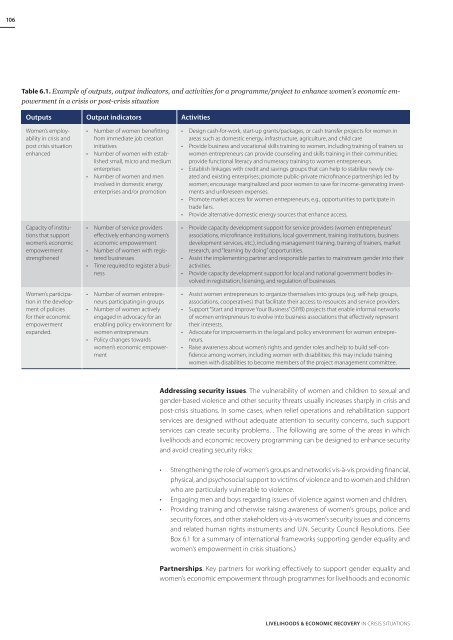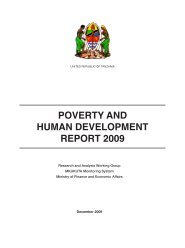Download PDF (4.08 MB) - ReliefWeb
Download PDF (4.08 MB) - ReliefWeb
Download PDF (4.08 MB) - ReliefWeb
Create successful ePaper yourself
Turn your PDF publications into a flip-book with our unique Google optimized e-Paper software.
106<br />
Table 6.1. Example of outputs, output indicators, and activities for a programme/project to enhance women’s economic empowerment<br />
in a crisis or post-crisis situation<br />
Outputs Output indicators Activities<br />
Women’s employability<br />
in crisis and<br />
post crisis situation<br />
enhanced<br />
Capacity of institutions<br />
that support<br />
women’s economic<br />
empowerment<br />
strengthened<br />
Women’s participation<br />
in the development<br />
of policies<br />
for their economic<br />
empowerment<br />
expanded.<br />
• Number of women benefitting<br />
from immediate job creation<br />
initiatives<br />
• Number of women with established<br />
small, micro and medium<br />
enterprises<br />
• Number of women and men<br />
involved in domestic energy<br />
enterprises and/or promotion<br />
• Number of service providers<br />
effectively enhancing women’s<br />
economic empowerment<br />
• Number of women with registered<br />
businesses<br />
• Time required to register a business<br />
• Number of women entrepreneurs<br />
participating in groups<br />
• Number of women actively<br />
engaged in advocacy for an<br />
enabling policy environment for<br />
women entrepreneurs<br />
• Policy changes towards<br />
women’s economic empowerment<br />
• Design cash-for-work, start-up grants/packages, or cash transfer projects for women in<br />
areas such as domestic energy, infrastructure, agriculture, and child care<br />
• Provide business and vocational skills training to women, including training of trainers so<br />
women entrepreneurs can provide counseling and skills training in their communities;<br />
provide functional literacy and numeracy training to women entrepreneurs.<br />
• Establish linkages with credit and savings groups that can help to stabilize newly created<br />
and existing enterprises; promote public-private microfinance partnerships led by<br />
women; encourage marginalized and poor women to save for income-generating investments<br />
and unforeseen expenses.<br />
• Promote market access for women entrepreneurs, e.g., opportunities to participate in<br />
trade fairs.<br />
• Provide alternative domestic energy sources that enhance access.<br />
• Provide capacity development support for service providers (women entrepreneurs’<br />
associations, microfinance institutions, local government, training institutions, business<br />
development services, etc.), including management training, training of trainers, market<br />
research, and “learning by doing” opportunities.<br />
• Assist the implementing partner and responsible parties to mainstream gender into their<br />
activities.<br />
• Provide capacity development support for local and national government bodies involved<br />
in registration, licensing, and regulation of businesses.<br />
• Assist women entrepreneurs to organize themselves into groups (e.g. self-help groups,<br />
associations, cooperatives) that facilitate their access to resources and service providers.<br />
• Support “Start and Improve Your Business” (SIYB) projects that enable informal networks<br />
of women entrepreneurs to evolve into business associations that effectively represent<br />
their interests.<br />
• Advocate for improvements in the legal and policy environment for women entrepreneurs.<br />
• Raise awareness about women’s rights and gender roles and help to build self-confidence<br />
among women, including women with disabilities; this may include training<br />
women with disabilities to become members of the project management committee.<br />
Addressing security issues. The vulnerability of women and children to sexual and<br />
gender-based violence and other security threats usually increases sharply in crisis and<br />
post-crisis situations. In some cases, when relief operations and rehabilitation support<br />
services are designed without adequate attention to security concerns, such support<br />
services can create security problems. . The following are some of the areas in which<br />
livelihoods and economic recovery programming can be designed to enhance security<br />
and avoid creating security risks:<br />
• Strengthening the role of women’s groups and networks vis-à-vis providing financial,<br />
physical, and psychosocial support to victims of violence and to women and children<br />
who are particularly vulnerable to violence.<br />
• Engaging men and boys regarding issues of violence against women and children.<br />
• Providing training and otherwise raising awareness of women’s groups, police and<br />
security forces, and other stakeholders vis-à-vis women’s security issues and concerns<br />
and related human rights instruments and U.N. Security Council Resolutions. (See<br />
Box 6.1 for a summary of international frameworks supporting gender equality and<br />
women’s empowerment in crisis situations.)<br />
Partnerships. Key partners for working effectively to support gender equality and<br />
women’s economic empowerment through programmes for livelihoods and economic<br />
Livelihoods & Economic Recovery in Crisis Situations





